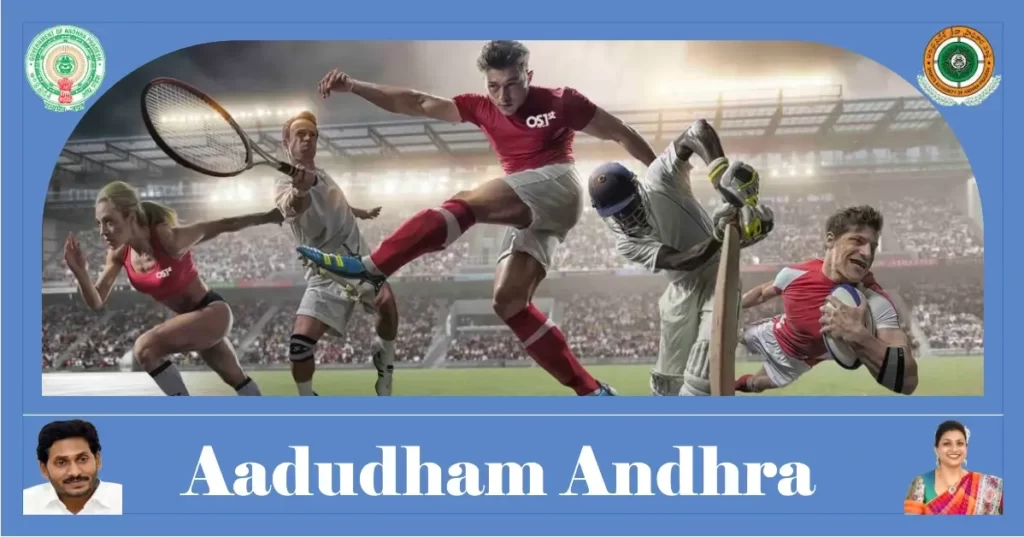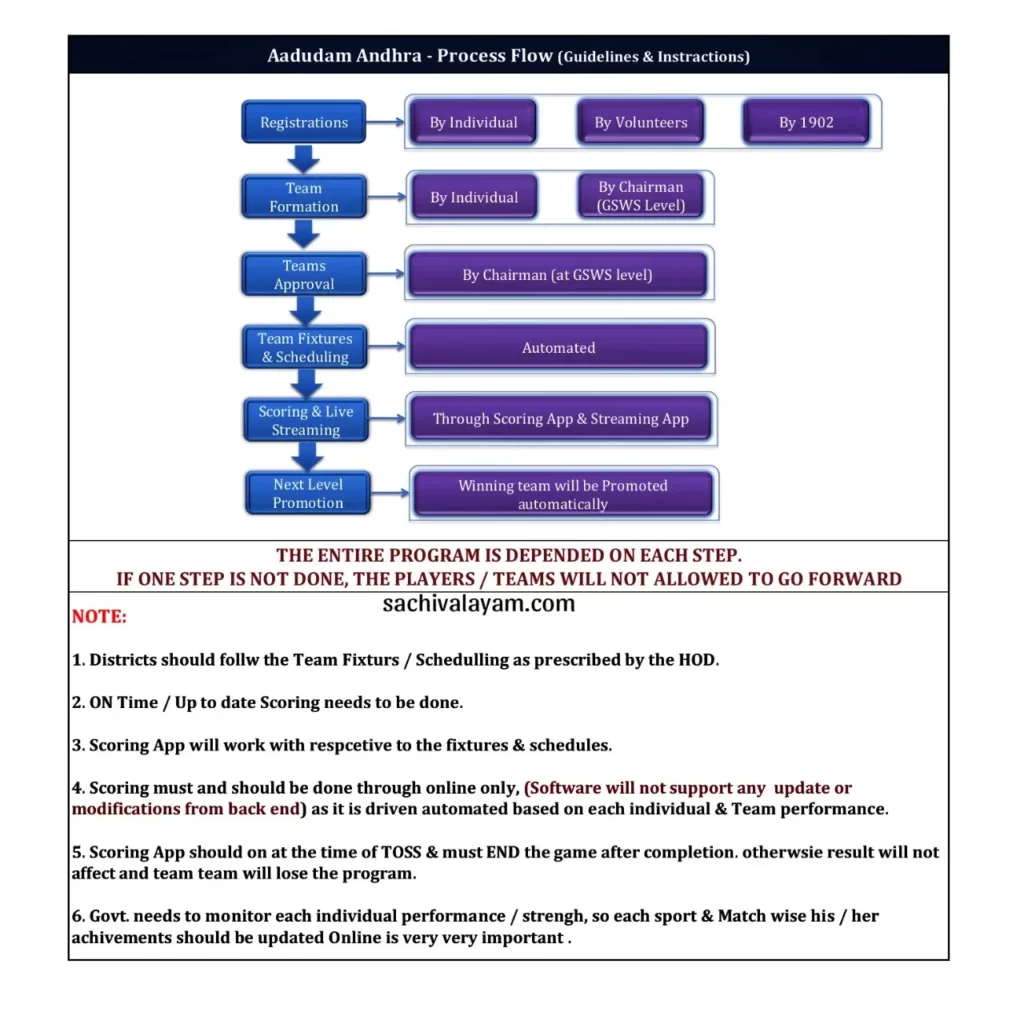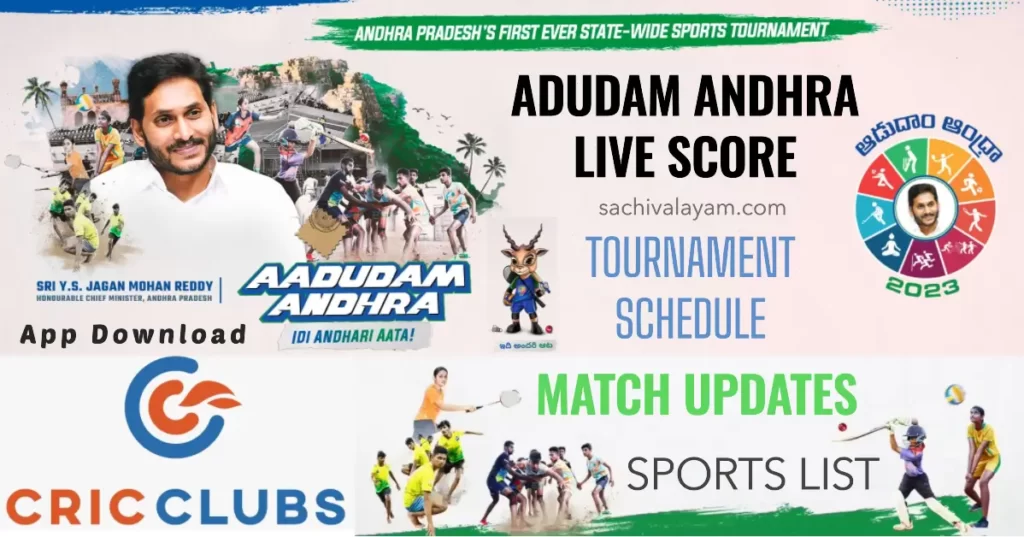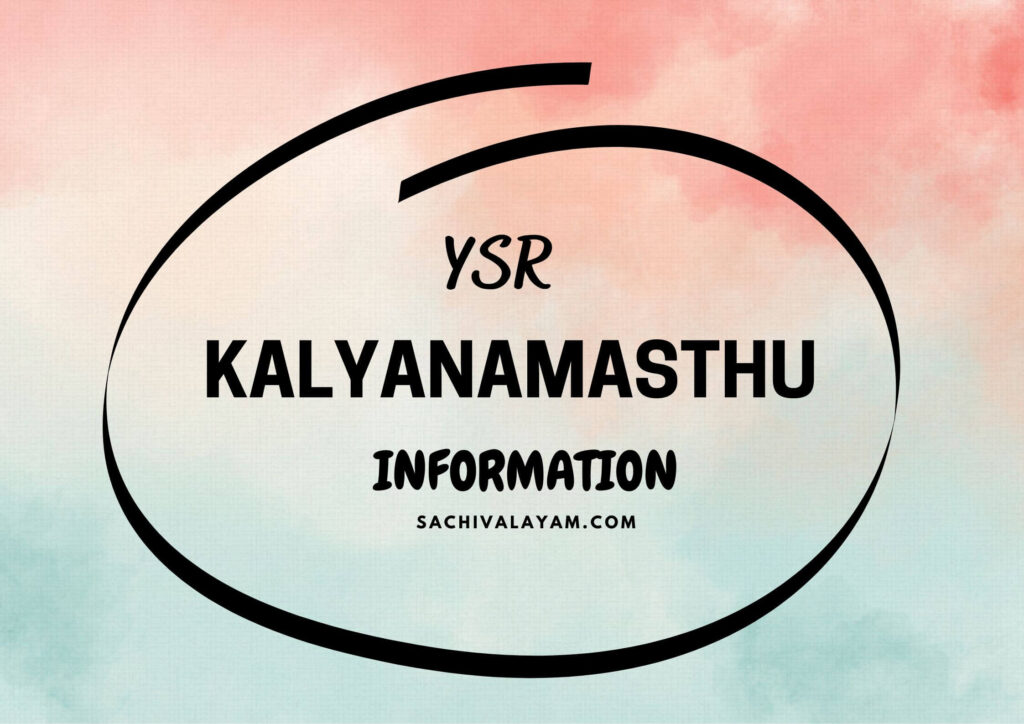The Aadudam Andhra program is a sports initiative by the Sports Authority Government of Andhra Pradesh. The program aims to promote sports and physical fitness among the youth of the state. For aadudham andhra 2023-24 registration
Table of Contents
ToggleLatest Updates
Aadudam Andhra Final (13-02-2024)
- విశాఖలోని వైఎస్ఆర్ క్రికెట్ స్టేడియంలో జరిగే ముగింపు వేడుకల్లో పాల్గొననున్న సీఎం జగన్.
- అన్ని దశల్లో కలిపి రూ.12.21 కోట్ల నగదు బహుమతులు. రూ.37 కోట్ల విలువైన స్పోర్ట్స్ కిట్లు అందజేత
Aadudam Andhra Schedule (25-12-2023)
Registrations
- it will be kept open in PS login till end of village level matches – on spot registration may also happen.
Team formations – PS/Admin login
- possible teams to be completed by Saturday end
Fixtures and schedule – PS/Admin login
25th Monday
- Ambassadors have to attend on 26th
- Ambassadors list is attached in JC login and PS/Admin login
Cric club
- app download and app training
- Result updation is critical
- After each match at vsws and Mandal level
- Result updation can also be done via PS/Admin login and mpdo login
- Only online report would be taken as progress
Kits
- To reach their destination and online acknowledgement to be don
T shirt and Cap
- To reach Mandal level finally
- Only to be given to winning players coming to Mandal level from village
- Tech committee report to be submitted to head office within 2 days after receipt of T shirt and Caps at district level
Final Team formations at VSWS level
- At the end of village games final team with best players from the sachivalayam will be formed by PS
- For example – best 16 from sachivalayam will form final cricket team irrespective he/she was Part of any team or his/her team won/lost.
Aadudam Andhra Edit Option Given (16-12-2023)
As many registrants were asking for options to change their teams/GSWS or sport preferences, we have now enabled a delete registration option.
Using this, any registered player can
- Delete their existing registration and register again with the updated info as per their preference.
- Change their registration from player to audience or vice versa
- Remove themselves from their current team and get added again to a new team of their choice
These features are now live and will be available to all registered users until 17th Dec when the registration period closes.
Aadudam Andhra Tournamnet Postponed (14-12-2023)
As per the request received from coastal districts in view of recent cyclonic impact and ongoing enumeration at the filed level, proposed Aadudam Andhra Tournamnet will begin from 26th of Decemeber.
‘ఆడుదాం ఆంధ్ర’లో వలంటీర్లే అంపైర్లు (09-12-2023)
ఈ నెల 26 నుంచి ప్రారంభమయ్యే ఆడుదాం ఆంధ్ర క్రీడల్లో వలంటీర్లకు కీలక బాధ్యతలు అప్పగించనున్నారు. ఇప్పటికే క్రీడాకారుల రిజిస్ట్రేషన్, ప్రచారం బాధ్యతలు చేపడుతున్న వారికి అంపైరింగ్పై శిక్షణ ఇస్తున్నారు. తొలి దశలో గ్రామ/ వార్డు సచివాలయాల పరిధిలో జరిగే క్రికెట్, ఖో-ఖో, కబడ్డీ, బ్యాడ్మింటన్, వాలీబాల్ పోటీలకు వారు రిఫరీలుగా వ్యవహరిస్తారు. PETల కొరత నేపథ్యంలో ప్రభుత్వం ఈ దిశగా అడుగులు వేస్తోంది.
Adudam Andhra Registration Online
Online registration Already Started. Anyone who is at least 15 years old can participate, except for volunteers and secretariat staff.
- adudam andhra ap gov in login games registration online last date is 17-12-2023
The festival will be held in five categories:
- Village level: This category will involve competitions in traditional games and sports. for both men & women.
- Mandal level: This category will involve competitions in cricket, Badminton, volleyball, kabaddi, kho-kho, and other popular sports.
- District level: This category will involve competitions in the same sports as the mandal level, but with a higher level of competition.
- State level: This category will be held for the top teams from the district level competitions.
- National level: This category will involve competitions in the same sports as the state level, but with the opportunity to represent Andhra Pradesh at the national level.
Adudam andhra dashboard links login
Aadudham Andhra Games List & Eligibility
The Aadudam Andhra tournament is an opportunity for young people in Andhra Pradesh to showcase their sporting talent. The festival will also help to promote physical fitness and healthy living among the youth.
Eligibility Criteria For Adudam Andhra Registration
- Be a citizen of Andhra Pradesh state
- Be at least 15 years old
- Not be an employee or volunteer of the state secretariat
- Be familiar with the game rules and regulations as set by the Sports Authority of Andhra Pradesh
Adudam Andhra Games List and Team size:
Each game will have two teams. The team sizes are as follows:
- Kabaddi: 12 players per team
- Kho-kho: 16 players per team
- Cricket: 16 players per team
- Volleyball: 12 players per team
- Badminton: 2 players per team
Important dates - Competitions:
Competitions will be held at the following levels: (New Dates Updated Soon..)
- Village level: December 26 2023
- Mandal level: December 21-January 4, 2024
- Assembly constituency level: January 5-10, 2024
- District level: January 11-21, 2024
- State level: January 22-26, 2024
Aadudam Andhra User manuals
Live-Scoring
Live Score of Aadudam Andhra Games and Points Table will be Updated Daily
- Badminton – CLICK HERE
- Cricket – CLICK HERE
- Kabaddi – CLICK HERE
- Kho-Kho – CLICK HERE
- Volleyball – CLICK HERE
Aadudam Andhra Logo Social Media
Kittu - The Blackbuck
Official mascot of Aadudam Andhra, a sports initiative by the Government of Andhra Pradesh. KITTU is a blackbuck antelope, and symbolizes the spirit of agility, speed, and grace. These qualities are mirrored in the remarkable talents seen in every participant in Aadudam Andhra.
Competitive Games
Aadudam Andhra Cricket Match Format and Rules
Match Format
- All matches follow a 10-overs-a-side format, ensuring quick and exciting gameplay.
Rule Adherence
- BCCI rules and regulations govern the matches, with some specific variations.
Spirit of the Game
- Players and officials must adhere to the sportsmanship and spirit of the game as outlined in the MCC Laws of Cricket 2007 – 2019 Edition.
Team Composition
- Captains select 11 players and up to 5 substitute fielders in writing, with changes requiring the opposing captain’s approval.
Ball Type
- The matches are played with a red ball, influencing bowling and batting strategies.
Toss Procedure
- Toss for innings choice is supervised by a Match Umpire, ensuring fairness and transparency.
Umpire Appointment
- Umpires are appointed by the association and are generally not changed during matches, except in exceptional circumstances or due to illness or injury.
Umpire Decisions
- Umpires’ decisions are considered final and binding, with no provision for protests regarding their judgments.
Pre-Match Arrival
- Teams are required to report one hour before the scheduled match time, allowing for necessary preparations and formalities.
Players
- Each captain shall nominate 11 players plus 5 substitute fielders.
L1 & L2 Play
- Matches at the Grama/Ward Sachivalayam level and Mandal level will be contested using hard tennis balls, reflecting different levels of play and equipment standards.
L3 Play
- From Assembly Constituency Level onwards, cricket became a professional sport, played with specialized equipment and the use of a “Grace” cricket ball. This transition signifies a higher level of competition and adherence to professional standards.
Badminton
Badminton Court
The badminton court is a rectangular area with dimensions of 13.40 meters in length and 6.10 meters in width. The court is divided into two halves by a net that is suspended 1.55 meters from the ground at the center and 1.52 meters at the ends.
Shuttle
The shuttle, also known as a birdie, is a projectile used in badminton. It is typically made of plastic or feather and is hit with a racket. The shuttlecock is about 6.5 cm long and weighs about 5 grams.
Racket
The badminton racket is a light, handheld implement used to hit the shuttlecock. The racket is typically made of carbon fiber or aluminum and is about 68 cm long and 23 cm wide.
Toss
Before a badminton match begins, the players or captains conduct a toss to determine who will serve first and which end of the court they will start at. The player who wins the toss can choose to serve or receive first and can choose which end of the court they want to defend.
Scoring
A badminton match consists of the best of three games. The first player or team to score 21 points wins the game. If the score is tied at 20-20, the game continues until one player or team has a two-point lead. If the score is tied at 29-29, the first player or team to score the next point wins the game.
Change of Ends
The players or teams change ends of the court at the end of the first game, the end of the second game, and in the third game when one player or team first scores 11 points.
Faults
A fault is a violation of the rules of badminton. If a player commits a fault, their opponent is awarded a point. Some common faults in badminton include:
- Serving above waist level
- Not pointing the racket shaft towards the ground
- Dragging the leg
- Delaying the service
- Breaking the service
Lets
A let is a situation in badminton where a point is not awarded to either player. Some common lets in badminton include:
- The shuttlecock being unsighted
- Both the server and receiver faulting simultaneously
- An unforced situation occurring
Volleyball Court and Rules
Court Dimensions
The playing court in volleyball is a rectangular area measuring 18 meters long and 9 meters wide. The court is surrounded by a free zone at least 3 meters wide on all sides. This free zone is where the players warm up and where the ball can land before it is considered out of bounds.
Net Height
The net is placed vertically over the center line of the court and is set at a height of 2.43 meters for men and 2.24 meters for women. The net is suspended from a cable that is attached to two posts that are located on the sidelines of the court.
Team Composition
A volleyball team can have up to 12 players on its roster, but only 6 players can be on the court at any given time. The six players on the court are divided into three rows:
- Front row: The front row players are the ones who are responsible for blocking and attacking the ball.
- Back row: The back row players are the ones who are responsible for defending and passing the ball.
- Libero: The libero is a specialized back row player who is allowed to make unlimited substitutions. The libero is not allowed to serve, attack, or block the ball above the top of the net.
Match Format
Volleyball matches consist of three sets, with the first two sets played to 25 points and a third set to 15 points. Each set must be won by a margin of two points. The first team to win two sets wins the match.
Timeouts
Two timeouts of 30 seconds each are allowed per set for each team. Timeouts can be used to strategize with players, make substitutions, or rest players.
Substitutions
Each team is allowed six substitutions per set. Substitutions can be made at any time during the play, except during the service.
Officials
Volleyball matches are officiated by a 1st Referee, 2nd Referee, Scorer, and line referees. The 1st Referee is responsible for overseeing the match and making all of the final decisions. The 2nd Referee assists the 1st Referee and also calls linesmen’s faults. The Scorer keeps track of the score and the number of timeouts that each team has taken. The line referees are responsible for calling linesmen’s faults.
Basic Rules
There are a few basic rules that all volleyball players must follow:
- Double Contact: A player may not hit the ball twice in succession, except in the case of a block.
- Body Contact: It is legal to contact the ball with any part of a player’s body.
- Illegal Actions: Catching, holding, or throwing the ball is considered illegal.
- Simultaneous Contact: If two or more players contact the ball at the same time, it counts as one play, and any of those players can make the next contact unless it’s the team’s fourth hit.
- Blocking Serve: A player cannot block or attack a serve from on or inside the 3-meter line.
- Front Line Rotation: After the serve, front-line players can switch positions at the net.
- Five Players: If a team has only five players, they will have a ghost position, causing them to lose the point when that position is serving.
- Refereeing Team: The referee/duty crew includes two referees, line judges, and a scorekeeper.
- Basic Violations: Violations result in a lost point and include stepping on or across the service line when serving, failing to serve the ball over the net successfully, illegal ball contact, touching the net during play (with exceptions), reaching over the net during blocking or attacking, crossing the centerline, serving out of order, and back-row players blocking and spiking when part of their body is above the top of the net (illegal block).
Kabaddi: Team, Weight, Match Duration, Scoring, Timeouts, Substitutions, Tiebreaker Rules
Team Composition
- A kabaddi team consists of 7 to 12 players, but only 7 players from each team participate in the match.
Weight Limits
- For men, players must weigh below 85 kg.
- For women, players must weigh below 75 kg.
Match Duration
- Men’s matches are 40 minutes divided into 2 halves of 20 minutes each with a 5-minute break in between.
- Women’s matches are 30 minutes divided into 2 halves of 15 minutes each with a 5-minute break in between.
Scoring System
- Each team scores one point for every opponent they get out.
- If a team scores an all-out (eliminates all players of the opposing team), they score two extra points.
- Out and revival rules are applicable.
Timeouts
- Each team is allowed two timeouts of 30 seconds in each half.
Official Time Out
- The referee/umpire can call an official time-out in case of injuries, interruptions by outsiders, ground issues, or unforeseen circumstances. This time is added to the match duration.
Bonus Point
- The bonus line rule is applicable when there are a minimum of 6 defenders in the court, and there is no revival for a bonus point.
Substitutions
- Up to five substitutions from five reserve players are allowed with the referee’s permission at any time.
Tiebreaker Rules in Knockout Matches
- In case of a tie in knockout matches:
- Both teams should field 7 players on the court.
- The baulk line is treated as a baulk line cum bonus line, and all bonus point rules apply.
- Each team is given 5 raids by different raiders to raid alternately.
Golden Raid
- If there is still a tie after 5-5 raids, a fresh toss will be taken. The team that wins the toss gets the chance to raid first, known as the Golden Raid.
- If the tie persists after the Golden Raid, the opponent team is given a chance for a Golden Raid.
- If there is no result after both Golden Raids, the winner is decided by a toss.
Super Catch
- When a raider is caught out by themselves, and 3 or 4 defenders are defending, it is called a Super Catch.
Do or Die Raid
- The third raid after 2 empty raids by a side is called the Do or Die raid.
Officials
- The officials for the sport include a Referee, Umpire-I, Umpire-II, Scorer, Assistant Scorer-I, Assistant Scorer-II, 30 seconds timekeeper, and 3rd raid scorer.
Kho Kho Match Duration and Foul Rules
Turn Duration
A Kho Kho match can be played in two different formats:
Four Turns: Each turn lasts for 5 minutes, resulting in a total of 20 minutes of gameplay (2 innings x 4 turns).
Two Turns: Each turn lasts for 7 minutes, resulting in a total of 14 minutes of gameplay (1 inning x 2 turns).
Fouls
Several actions are considered fouls in Kho Kho:
Early Getting: A chaser is considered to be “getting” when they enter the opponent’s half of the court. If a chaser enters the opponent’s half before the chaser’s partner crosses the center line, it is considered an early getting foul.
Crossing the Center Lane: A chaser cannot cross the center line into the opponent’s half of the court. Touching the center line is not a foul, but going completely into the opponent’s half is.
Shoulder Direction Foul: A chaser can only foul a defender by facing them directly. Receding or turning away from the defender is not considered a foul.
“Kho” Utterance: Utterances of “kho” or similar actions are not considered fouls.
Late Entries or 2 Kho Rules: For the 2nd and 3rd batch entries, the late entries or the 2 Kho rules apply.
Advantage Rule: The advantage rule states that a foul will be given only if the active chaser deliberately fouls when near the defender.
Unnecessary Whistles: Referees are advised to avoid blowing unnecessary whistles that may disrupt the flow of the game.
Additional Rules
These rules ensure fair play, adherence to the specific regulations of Kho Kho, and provide a framework for addressing any unforeseen situations that may arise during the game.
Apart from the rules mentioned above, any disputes or situations that arise during the game will be governed by the federation rules. In case of any unresolved disputes, the decision of the organizing committee will be final.
Adudham Andhra Sports Equipment
Cricket Equipment:
- Stage I – Basic Cricket Kit for Men
- Stage I – Basic Cricket Kit for Women
- Cricket Leather Balls
- Stage II – Professinal Cricket Kit for Men
- Stage II – Professional Cricket Kit for Women
Badminton Equipment
- Badminton Nylon Net
- Stage – I Badminton Racquets
- Stage – II Badminton Racquets
- Nylon Shuttlecock
- Feather Shuttlecock
Volleyball Equipment
- Stage I – Volley Ball
- Stage II – Volleyball
- Volleyball Net
Kabaddi Equipment
- Kabaddi Knee Caps
Kho-Kho Equipment
- Kho Kho Anklets
Tennikoit Equipment
- Tennikoit
Non-Competitive Games for the Gram/Ward Sachivalayam Level
The Organizing Committee at the Grama/Ward Sachivalayam Level is responsible for selecting appropriate non-competitive games that encourage participation and involvement from a wide range of individuals. Some examples of non-competitive games that may be offered include:
2K/3K Marathon Run: These shorter-distance marathons are suitable for people of all fitness levels and provide a fun and challenging way to get exercise and explore the local community.
Yoga: Yoga is a mind-body exercise that combines physical postures, breathing techniques, and meditation to promote relaxation, stress reduction, and overall well-being.
Tennikoit: Tennikoit is a traditional Indian game similar to badminton or tennis, played with a wicker ring and a ball. It is a fun and easy-to-learn game that can be enjoyed by people of all ages.
Other Games: Additionally, the Organizing Committee may consider other non-competitive games based on the interests and demands of the public.
MATCHES SCHEDULE - COMING SOON!
| Aadudam Andhra State Level Prize | |
| Kho Kho, Kabaddi, Cricket, Volleyball Prize | 1st Rs 500000, 2nd Rs. 300000, & 3rd Rs. 200000 |
| Badminton | 1st Rs. 200000, 2nd Rs. 100000, & 3rd Rs. 50000 |
| Aadudam Andhra District Level Prize | |
| Kho Kho, Kabaddi, Cricket, Volleyball Prize | 1st Rs 60000, 2nd Rs. 30000, & 3rd Rs. 10000 |
| Badminton | 1st Rs. 35000, 2nd Rs. 20000, & 3rd Rs. 10000 |
| Aadudam Andhra Constituency Level Prize | |
| Kho Kho, Kabaddi, Cricket, Volleyball Prize | 1st Rs. 35000, 2nd Rs. 15000, & 3rd Rs. 5000 |
| Badminton | 1st Rs. 20000, 2nd Rs. 10000, & 3rd Rs. 5000 |






Aadudham andhra